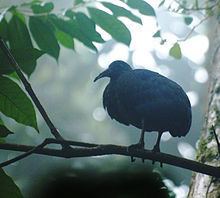Higher classification Bostrychia | Phylum Chordata Scientific name Bostrychia bocagei Rank Species | |
 | ||
Similar Olive ibis, Bird, Bostrychia, Spot‑breasted ibis, Malagasy sacred ibis | ||
The São Tomé ibis (Bostrychia bocagei), also known as the dwarf olive ibis, is a critically endangered bird that is endemic to São Tomé off the western coast of Central Africa. Once thought to be a subspecies of the larger olive ibis, it is now classified as a distinct species.
Contents
Description
The São Tomé ibis's measurements include: wings 248 mm; bill 73 mm; tarsus 52 mm; and tail 95 mm. The head is dull olive with black surrounding the eyes and base of the bill. The wing-coverts and mantle are slightly bronzed.
It is silent most of the time, but when disturbed it gives various coughed grunts, and a harsh honking when going to roost. Its call could also be described as a stressed kàh-gàh kàh-gàh.
Habitat and ecology
It is found in primary forest below 450 m altitude. It forages for food on the forest floor with sparse undergrowth, especially where the ground has been disturbed by wild pigs, and in swampy areas bordering watercourses.
Population and threats
The extremely small population of São Tomé ibises contains only around 50 to 249 individuals. Due to this, it is listed as Critically Endangered on the IUCN Red List.
Introduced species could negatively affect the numbers of these birds. Habitat loss is another threat, and road development has increased access to previously remote areas. They also may be hunted. A national park and the protection of threatened species in São Tomé have been proposed, but currently the forests are unprotected.
